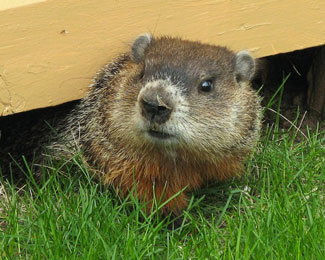Yes, Woodchucks Do Too Hibernate
By Chris Williams on January 16, 2015.
My buddy and I have a bet riding on this. There’s a woodchuck that has a burrow in my backyard. I haven’t seen him around lately and I say he’s in his burrow hibernating and he’ll be out again when the weather gets warm in the spring. My buddy says that woodchucks are active outside all winter, so this guy must have died or moved to another yard. Who’s right? J. T., Hudson, MA
 You win! Woodchucks (also known as groundhogs) are one of the few animals that do have true hibernation. If you think about the famous woodchuck, Punxsutawney Phil, you’ll recall that the legend has to do with whether he sees his shadow as he comes out of hibernation (or more precisely, as he’s yanked out of hibernation in early February).
You win! Woodchucks (also known as groundhogs) are one of the few animals that do have true hibernation. If you think about the famous woodchuck, Punxsutawney Phil, you’ll recall that the legend has to do with whether he sees his shadow as he comes out of hibernation (or more precisely, as he’s yanked out of hibernation in early February).
In fall, woodchucks work hard to put on fat for winter. They’re active in the daytime, foraging mostly in early morning and early evening. Woodchucks are vegetarians, so what they fill up on may be your garden plants or vegetables (see How Many Tomatoes Can a Woodchuck Chuck?). From late fall (late October to early November) until late February or early March, woodchucks are basically out of commission snoozing away in their dens. The first heavy frosts will usually push them into their burrows.
During this time, a hibernating woodchuck can lose 20 to 30% of its body weight (a single adult can weigh up to 12 pounds pre-hibernation). Maybe you need to buy your buddy a drink though, since it’s not unusual for a woodchuck to break its hibernation once or twice during the winter and make an outside appearance.
Woodchucks are solitary so it’s either a he, or a mom with young in your yard burrow. If it’s a male, he may be out and about before spring, though. The males usually come out of hibernation before the females and can travel long distances looking for a mate since breeding season is March-April.
For more on woodchucks, see Woodchuck or Groundhog – It’s the Same Pest!
Photo credit: Gilles Gonthier / Foter / CC BY
Stay up-to-date with Colonial Pest’s email newsletter!